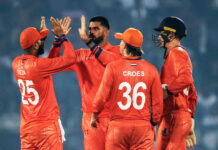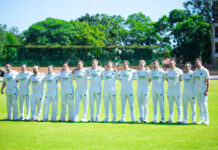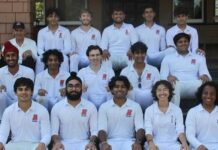In 2007, the Nepalese women’s cricket team made its international debut in the inaugural ACC Women’s Tournament held in Malaysia. Despite finishing as runners-up to Bangladesh in the final, it was a significant achievement for the team. The then-skipper, Nary Thapa, who recently retired from all forms of cricket, was named the bowler of the tournament.
Bangladesh proved too strong for Nepal in the final, chasing the target inside 10 overs. Batting first, Nepal could only manage 26/8 in 18 overs in a rain-affected match. The success of the tournament goes to former Nepal captain Lekh Bahadur Chhetri, who led the foundation of women’s cricket in Nepal. He was also the team manager on that tour.
ACC Development Manager Rumesh Ratnayake was quick to praise Nepal, stating, “Nepal could reach Bangladesh’s level in two years.” Although Nepal has struggled to live up to its early potential since then, that’s a topic for another day.
Seventeen years later, only a few cricketers from that time are still actively playing. One of them is Ritu Kanoujiya, who turns 40 next month. She embodies resilience and passion. At 40, most people would stop playing sports, let alone cricket in a country like Nepal, where women’s cricket is still a fledgling sport. Kanoujiya has spent more than 17 years playing for Nepal and various domestic teams, first for the Armed Police Force and later for Sudur Paschim, her home state. When asked about her motivation to continue playing cricket for so long, she said she had no choice, as she had quit her studies long ago to focus on the sport.
Early Days and Playing Career
Kanoujiya began playing cricket with her brothers. She was among the first batch of Nepali cricketers to participate in the ACC Women’s Tournament. In the final, she opened both the batting and bowling and also took a wicket. She was Nepal’s second-highest run-scorer, behind only Madhu Thapa, who last played for the national team in 2011 during a tour of Pakistan. Kanoujiya also took four wickets in the tournament.
Two years later, the all-rounder captained Nepal at the ACC Women’s Twenty20 Championship in 2009, where Nepal finished third after beating China in the third-place playoff. Nepal lost to the eventual winners, Hong Kong, in the semi-final by seven wickets. This tournament also marked the debut of former skipper Rubina Chhetry.
Kanoujiya was part of the Chitwan Rhinos women’s team that won the inaugural edition of the Women’s Champions League held in Kathmandu in 2019. She was the joint highest wicket-taker for her side, with seven wickets alongside her teammate Bindu Rawal. She contributed 1/11 and 14 runs in the final, leading her side to a 5-wicket win over Chhetry’s Kat Queens Kathmandu.
Although she hasn’t featured in any international matches since 2017, her last major tournament was the ICC Women’s T20 World Cup Asian Qualifiers. In this tournament, Nepal suffered a soul-crushing 5-run defeat against UAE while chasing a low total of 80. Walking out to bat at 41/7, Kanoujiya scored an unbeaten 23 off 22 balls, but it wasn’t enough. She also took 2/9 in her three-over spell.
Even at 40, she has managed to keep herself fit, thanks to her disciplined diet and fitness routines. She remains determined to play cricket and groom young talent in the domestic circuit. She occasionally travels to India for training and matches. She is currently coaching in the Baitadi district while also fulfilling her duties for her state.
Current State of Women’s Cricket
According to Kanoujiya, the inconsistency in women’s cricket is the main reason for the team’s erratic performances.
“I believe there is room for improvement, especially in batting. Here, the coach gets changed either after one year or one tournament. There should be separate coaches for fielding and bowling, like in men’s cricket. Also, if someone is given a coaching tenure for 2-3 years, they will perform better. The teams [Malaysia and Hong Kong] that we used to defeat are now beating us. Indoor tournaments alone won’t lead to improvement. We need to play weekly tournaments on the ground,” she opines.
When asked about poor running between the wickets, she pointed to a lack of regular fitness training. “CAN has to take the initiative. They need to organize month-long camps, not just one-week camps. Then, Nepal’s batting, fielding, and bowling will improve.”
Domestic Success
Kanoujiya has won multiple titles with both APF and Sudur Paschim province. She was part of the Sudur Paschim team that won the Prime Minister Cup Women’s T20 National Cricket Tournament last year, defeating Province One by six wickets for the first time.
Under her captaincy, Sudur Paschim reached the final of the Lalitpur Mayor’s Cup in two consecutive seasons, 2021 and 2022. However, on both occasions, they could not clear the final hurdle, losing to the Armed Police Force (APF).
Earlier this year, in May, she was part of the Sudur Paschim team that suffered a painful two-run loss against APF once again. Unfortunately, Kanoujiya bagged a diamond duck and saw her team fail to score five runs from the final four balls. She was the second-highest wicket-taker of the competition, with seven scalps, including one of Sita Rana Magar in the final.
She believes that each province can help young cricketers by providing scholarships for college and offering small incentives, even if it is just 4000-5000 rupees monthly. “This will help prevent players from leaving their provinces. The province builds and invests in the team, and department teams keep picking those players,” she concluded.
When asked about her retirement plans, Kanoujiya said, “I am doing Level 1 coaching, but I have not received a certificate because I haven’t completed the practical. I want to pursue a career as a coach after retirement.”
There’s no doubt she is in the twilight of her glittering career, but this hasn’t diminished her commitment to the game. She will forever be remembered as an inspirational figure in women’s cricket in Nepal. She hopes that CAN or the government will provide job opportunities for players after their retirement, as she mentioned.
You’re reading Emerging Cricket — brought to you by a passionate group of volunteers with a vision for cricket to be a truly global sport, and a mission to inspire passion to grow the game.
Be sure to check out our homepage for all the latest news, please subscribe for regular updates, and follow EC on Twitter, Facebook, LinkedIn and YouTube.
Don’t know where to start? Check out our features list, country profiles, and subscribe to our podcast. Support us from US$2 a month — and get exclusive benefits, by becoming an EC Patron.







